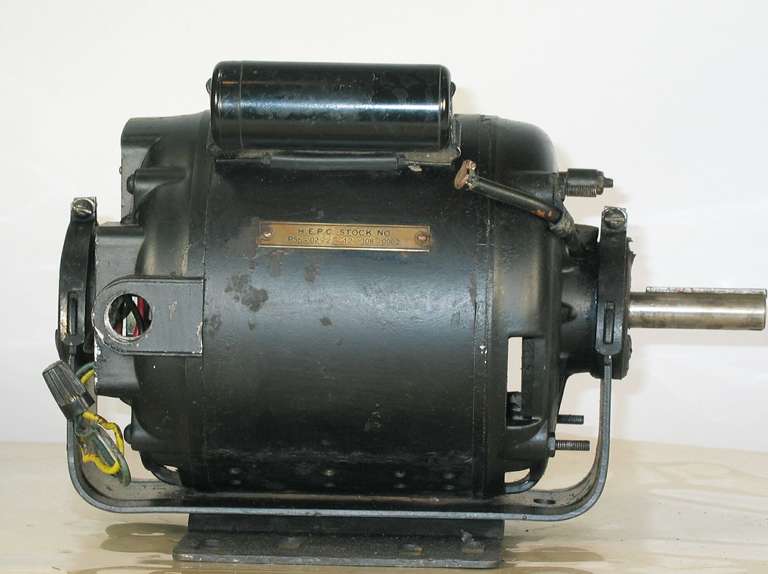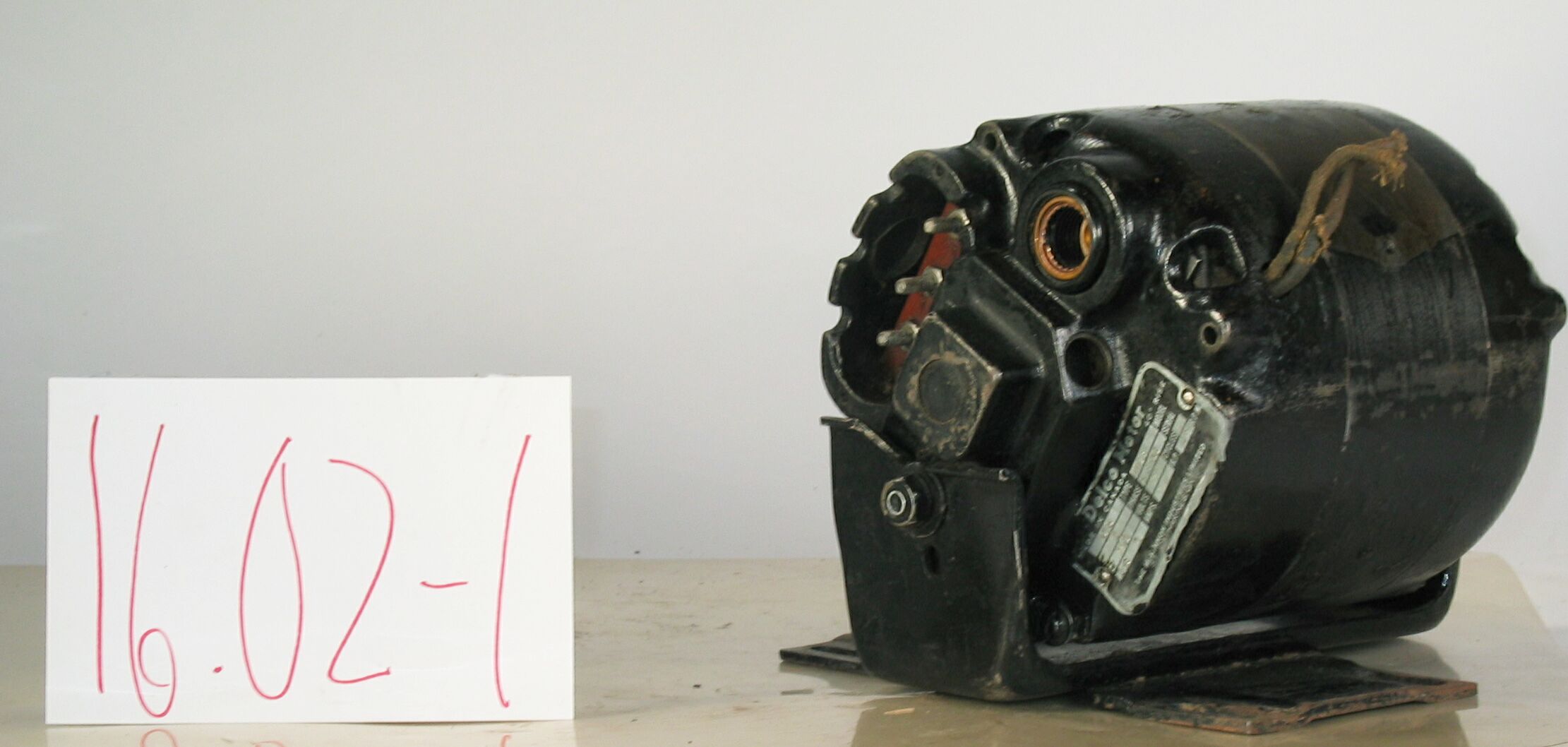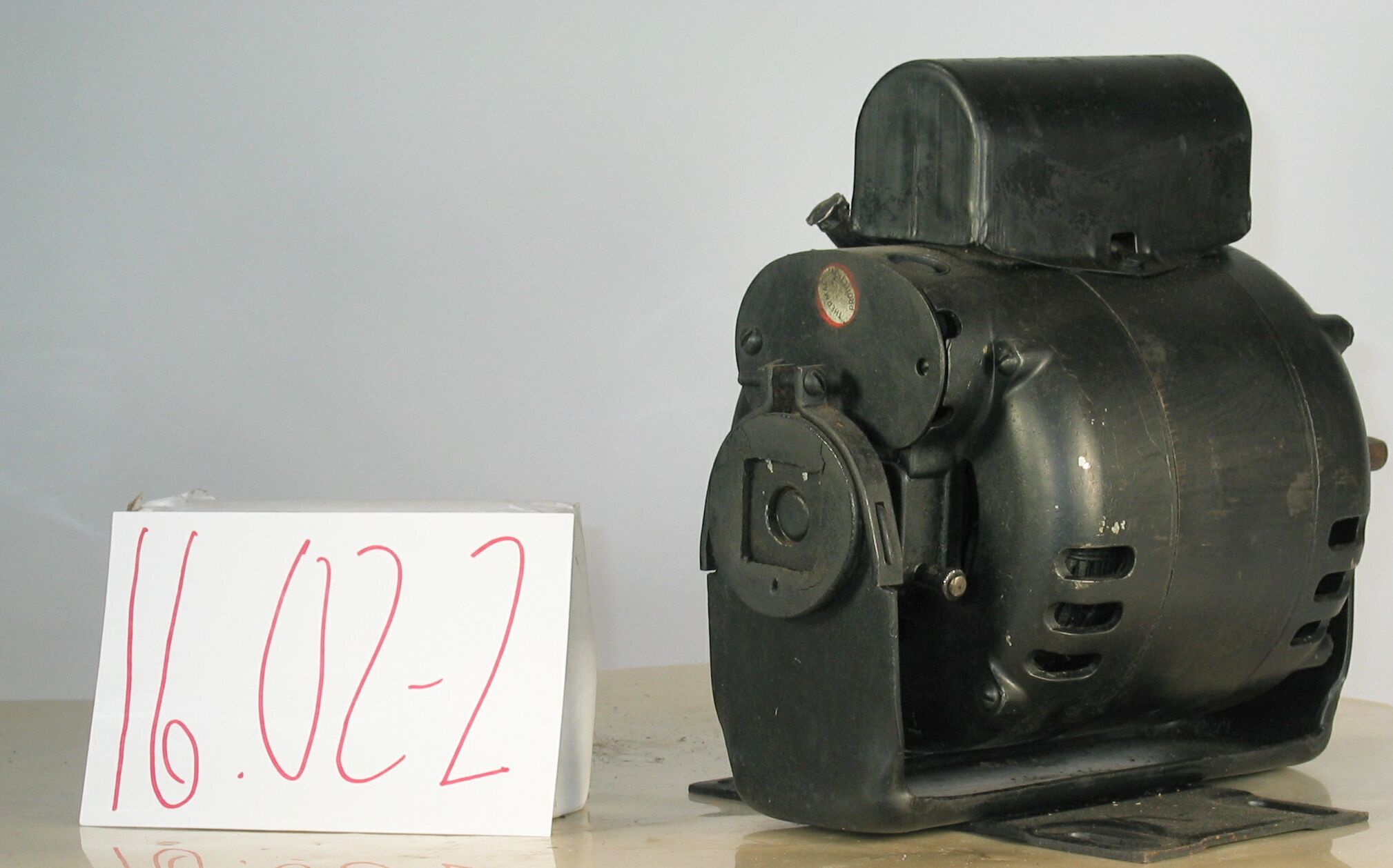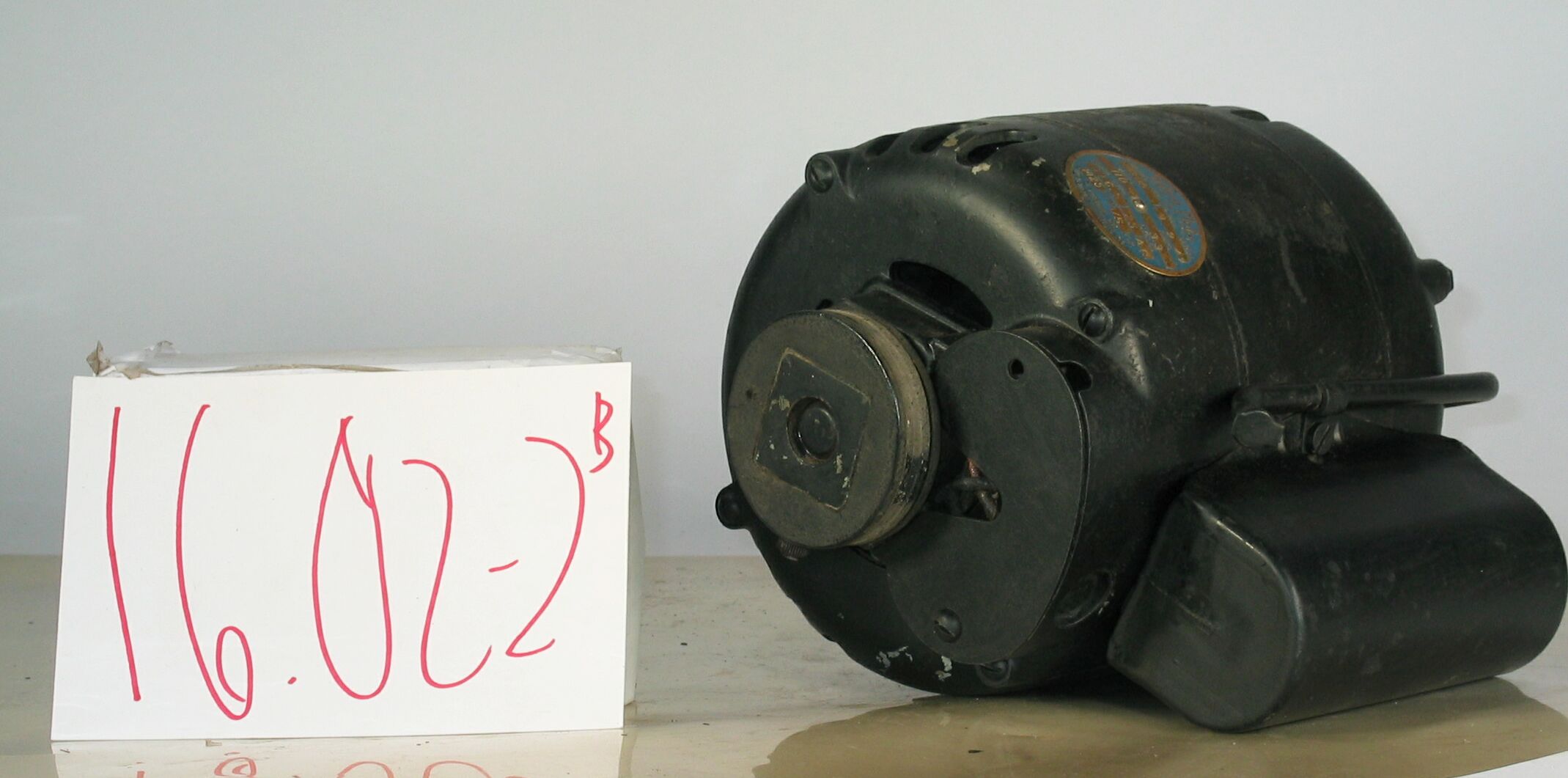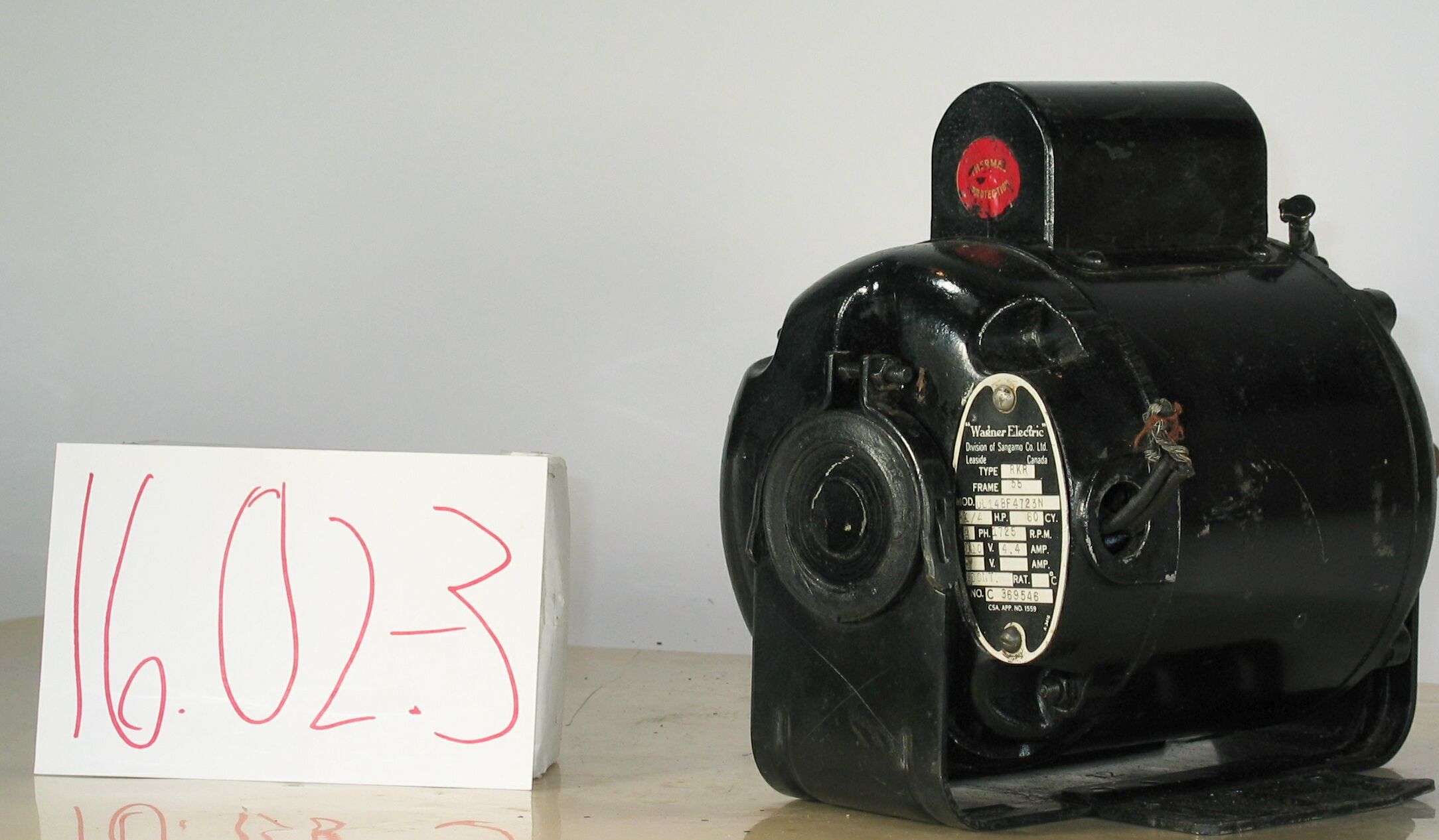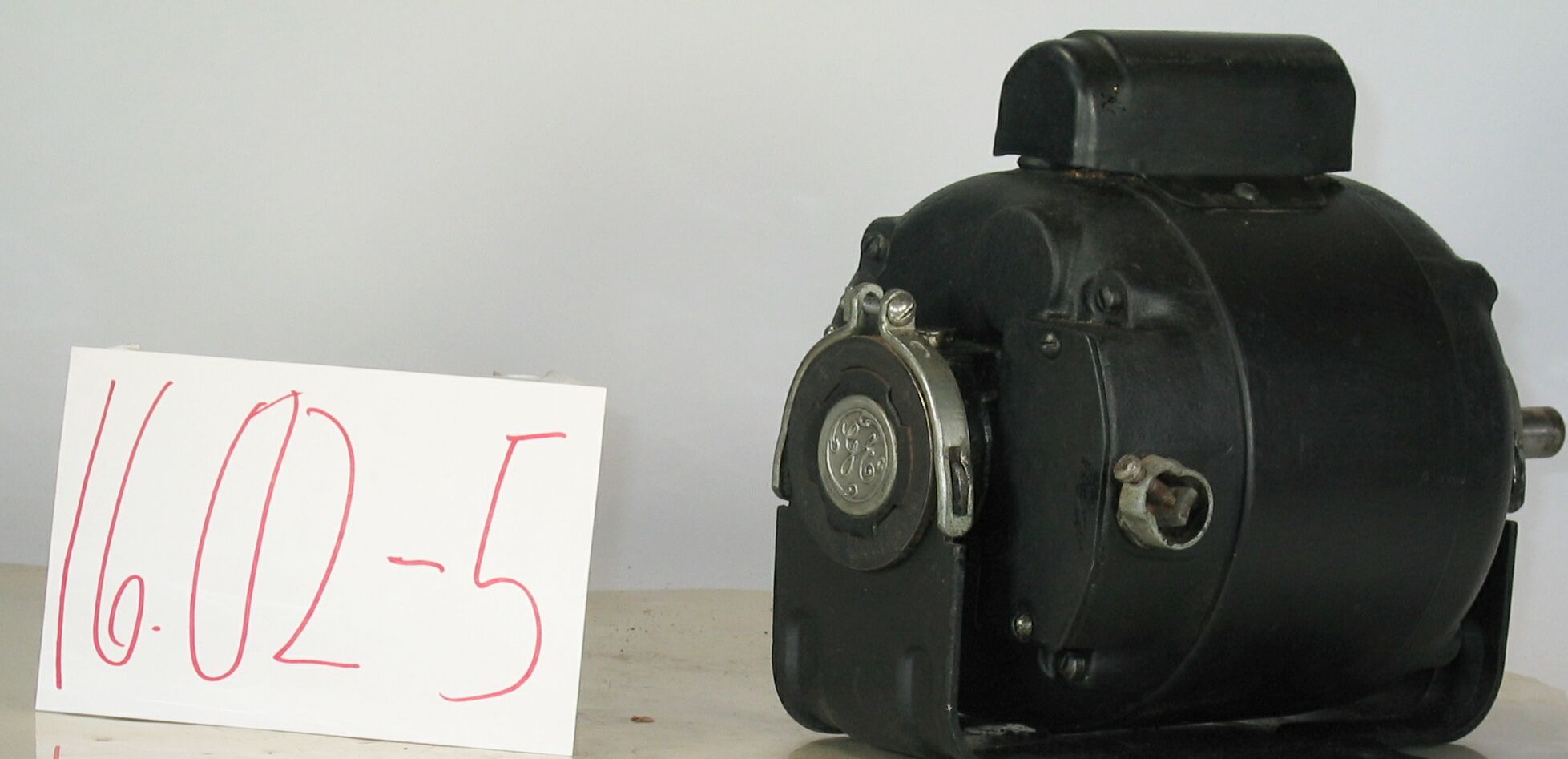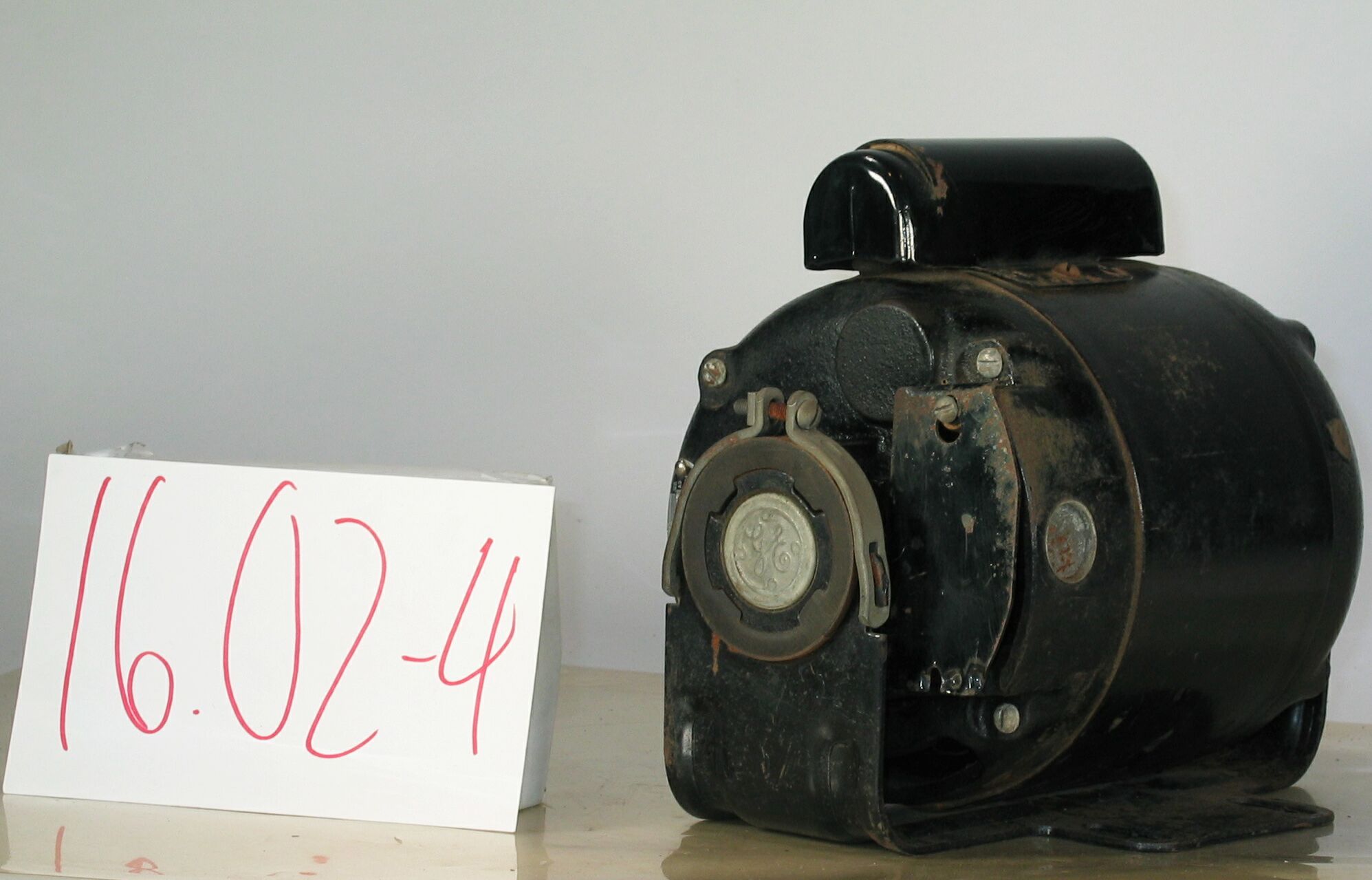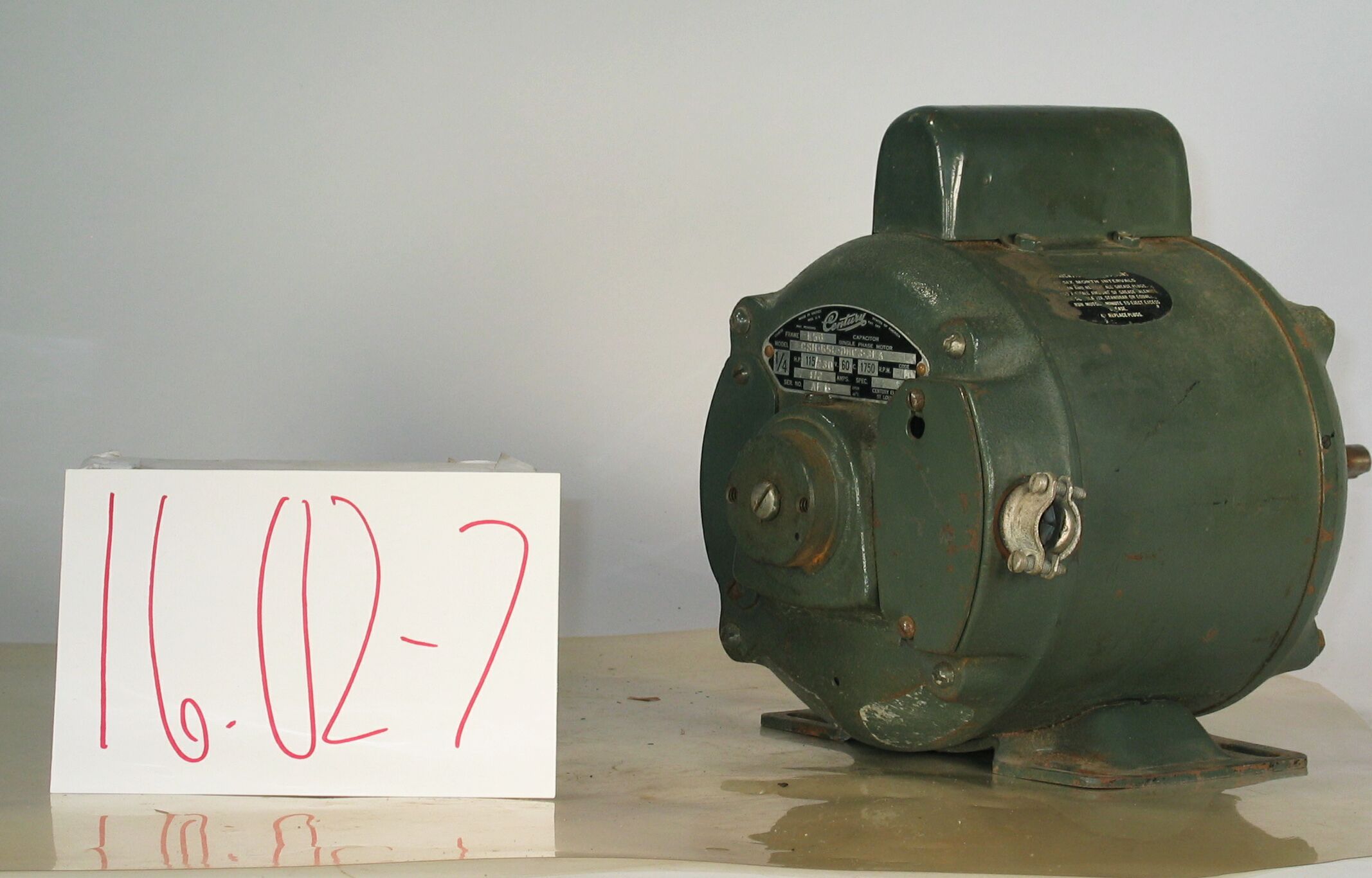16.02-6: Tamper 1955 60 Cycle Capacitor-Start Motor
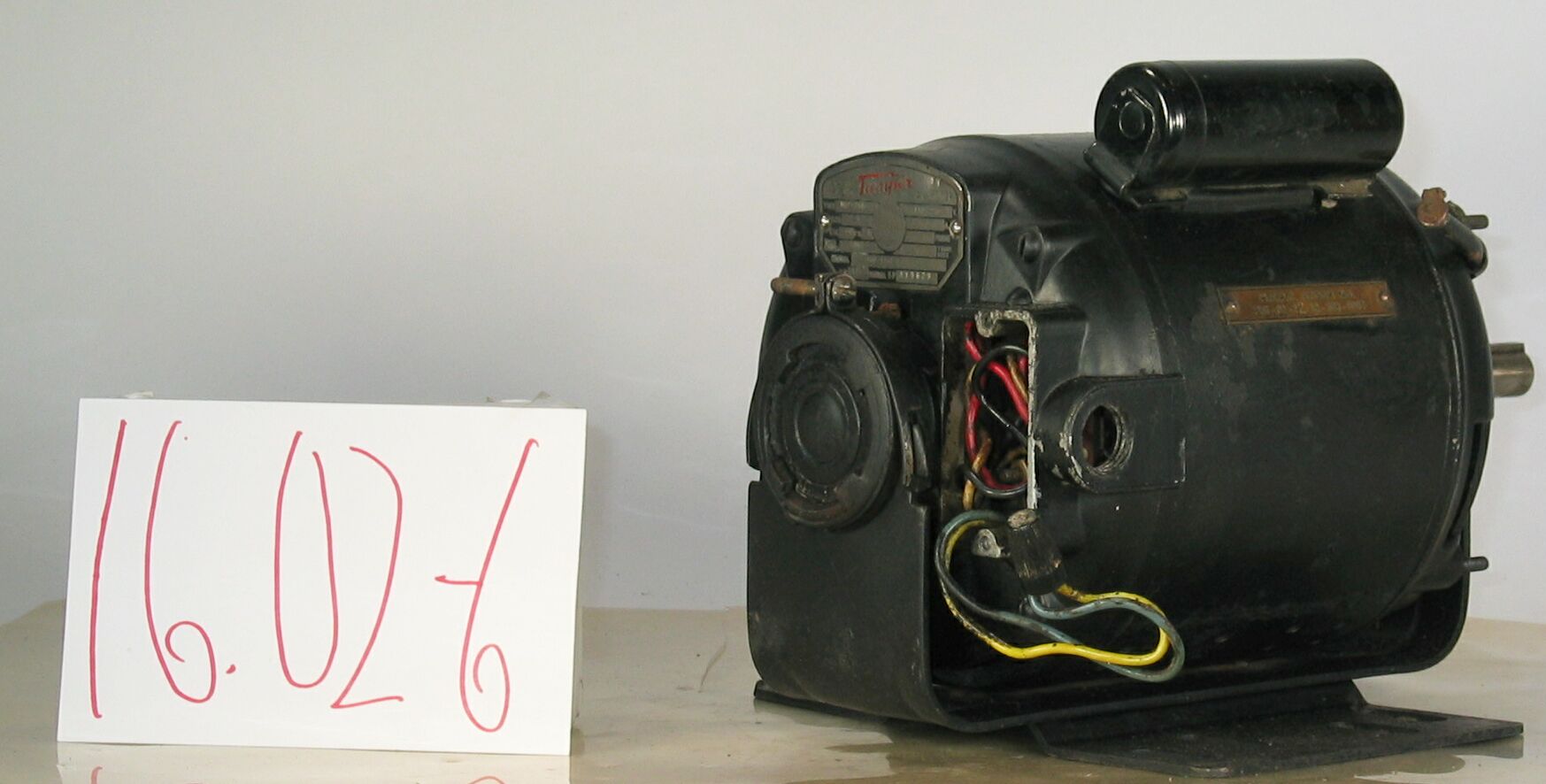
| HHCC Accession No. 2006.162 | HHCC Classification Code: 16.02-6 |
|---|
Description:
A mid 20th century, high tech, 60 cycle capacitor-start motor, made possible by the electrolytic, chemical capacitor and inherent, heat overload protection, with automatic reset, vibration isolating, rubber, torsion motor mount, engineered by a small, start-up Canadian Company, it tells many stories of the exceptionalities of its life and times. Tamper, Circa 1955
Group:
16.02 Electric Motors - Single Phase Capacitor Start and Capacitor Run Motors
Make:
Tamper
Manufacturer:
Tamper Electric, Montreal
Model:
MPR-1451-15BK
Serial No.:
A19629
Size:
12 x 9 x 9’h
Weight:
25 lbs.
Circa:
1955
Rating:
Exhibit, education, and research quality, illustrating a 1950’s Canadian engineered and manufactured 60 cycle capacitor start FHP induction motors, although un-remarkable in matters of innovation and excellence, tells important stories of the exceptionalities of its times, including: frequency standardization in Ontario, the post W.W.II expansion of the Canadian FHP motor manufacturing industry, and the manner in which the industry attracted new entrance, as small start up companies, as well as engineering giants such as GE. [Electrical junction box cover note included]
Patent Date/Number:
Provenance:
From York County (York Region) Ontario, once a rich agricultural hinterlands, attracting early settlement in the last years of the 18th century. Located on the north slopes of the Oak Ridges Moraine, within 20 miles of Toronto, the County would also attract early ex-urban development, to be come a wealthy market place for the emerging household and consumer technologies of the early and mid 20th century.
This artifact was discovered in the 1950’s in the used stock of T. H. Oliver, Refrigeration and Electric Sales and Service, Aurora, Ontario, an early worker in the field of agricultural, industrial and consumer technology.
Carries Ontario Hydro brass identification plate: HEPC Stock NO. P56-02-22-12-308-0002, a now rare marker of its life and times.
Type and Design:
Mid 20th century, high tech, FHP, capacitor-start motor design, 1/4 horsepower 60cycle, 110 volt, alternating current, Electrically reversible Dual voltage 110-220 volts
heavy, steel laminated body, designed to reduce magnetic [hysteresis] losses and reduce heat to improve electrical efficiency High starting torque motor for reciprocating refrigeration compressor application, Internal, centrifugally operated switching for automatic control of starting winding Advanced design electrolytic, chemical capacitor technology, with inherent mounting, Equipped with inherent, overload protection with automatic reset, Light weight die cast end bells, Bronze sleeve bearing with oil wicking, with corks Drive end extended safety oiler Multi slotted, large platform base for general replacement applications cover a wide range of mounting requirements Designed for ‘V’ belt drive applications, Ventilated, drip-proof housing, vibration isolating, rubber, torsion motor mounting
Construction:
Material:
Special Features:
Carries Ontario Hydro brass identification plate: HEPC Stock NO. P56-02-22-12-308-0002
Accessories:
Capacities:
Performance Characteristics:
Operation:
Control and Regulation:
Targeted Market Segment:
Consumer Acceptance:
Merchandising:
Market Price:
Technological Significance:
An historical artifact of the post W.W.II years in the evolution of FHP motor technology in Canada, which although un-remarkable in matters of innovation and excellence, tells important stories of the exceptionalities of its times: Of one of the largest and most sophisticated engineering mega-projects in Canadian history, frequency standardization in Ontario The remarkable, although short lived period of expansion of the Canadian FHP motor manufacturing industry, The manner in which the industry attracted new entrance, as small start-up companies, such as Tamper, as well as large manufactures with almost un-limited economic and engineering resources to draw on, such as GE [see ID#285 and 284]
Representative of FHP, capacitor start, induction motor technology, built for the post W.W.II rapidly expanding refrigeration equipment market, equipped with engineering features new for the period, including: Vibration isolating, rubber, torsion motor mounts Electrolytic, chemical capacitor technology, High tech inherent, overload, thermal protection with automatic reset. The motor exemplifies the latest in automatic over load protection, an on-going challenge through the early years in the development of unitary, fully automated refrigeration equipment, designed to operate safely, un-attended in the home. The motor exemplifies increasingly sophisticated developments in the field of electrolytic condensers, on which the capacitor start motor depended for its performance. Capacitors were getting smaller and more reliable, as well as appearing in more sophisticated, high tensile strength plastic enclosures sealed against moisture and with built-in, easy release, snap mounting brackets
The motor stands as a marker of the golden age in the post W.W.II expansion of the refrigeration industry in Canada, a period which saw the development of the commercial refrigeration market, based on open system refrigeration technology serving food stores, confectioneries, institutions and the like with fractional horsepower belt driven equipment, demonstrating remarkable versatility and inventiveness. It would be the last great period of expansion prior to the rush to re-equip the market with a new generation of hermetic [sealed] motor/compressors. Here the motor and compressor would both disappear from, sight both sealed in a single enclosure. The refrigeration motor, and the technology that made it possible, as it appears here, would disappear forever.
Industrial Significance:
The development and commercial production of the capacitor-start single phase FHP motor, starting in the mid 1940’s was a seminal event in the history of the HVACR field. The capacitor-start motor would come to replace the more costly and complex repulsion induction motor, RI [See Group 16.01], with one with fewer moving mechanical parts, quieter, more reliable and maintainable, typically at lower cost. By allowing for electrical switching between starting and running windings, it would facilitate external relay control, rather than internal mechanical mechanisms, as with the RI motor. It would therefore be amenable for use in hermetically sealed refrigeration systems. Early experimentation, leading to the eventual commercial development of the FHP, capacitor start-motor, began with the work of Steinnmetz [American engineer and inventor 1865 ‘ 1923], 40 years before. But commercial production had to await the development of practical capacitors of sufficient capacity, the chemical, electrolytic capacitor. Early, paper capacitors, large enough to provide the required phase shift for motor starting, where larger than the motor itself, and were subject to short operating life span [see Reference 3] Conventional industrial practice for refrigeration systems, with compressors operating at conventional speeds, in the 1930’s through 60’s, saw these motors attached by ‘V’ belt drive to the refrigeration compressor with a compressor fly wheel about three times that of the diameter of the motor pulley. [see reference #4]. Maintaining belt alignment and tension was a constant challenge, due to close coupling of motor and compressor for space saving.
Socio-economic Significance:
Socio-cultural Significance:
Not-with-standing a major depression and two world wars the first half of the 20th century was a period of exceptional ferment in the development and popular dissemination of FHP electric motor technology. Associated with the development were a number of driving forces, mutually supporting and interacting: Scientifically, the theoretical ground work for development of an astonishing array of electrical and electro-magnet devices had been laid by the early years of the 20th century, through the efforts of Faraday and Steinnmetz, among many others, Technologically, the work of Thomas Edison, among others, laid the foundation stones on which urban and rural electrification would proceed, enabling an new era in human experience, favoured with consumer goods and services, previously unimagined,
Economically, a favourable climate for capital investment in manufacturing capacity, methods and materials emerged, part of North America’s second industrial revolution, Socially and culturally the consumer society was born, nurtured by a pent up demand for an easier, more comfortable, pleasurable lifestyle, and the sense that 20th century electrical and electro-motive technology might be able to help. The FHP electric motor, engineered for 110 volt, single-phase house current, revolutionized life in the Canadian home. It enabled an astonishing list of appliances and labour saving devices. The revolution would take place in an astonishingly short period of time - for much of urban Canada much less than a decade. The electro-mechanical mechanization of the Canadian home was accomplished for much of urban Canada by the late 1930’s. But the early 20th century wonders of household mechanization would be dependent , in turn, on household ‘electrification’ Between them electrification and electro-mechanical mechanization changed everything. Almost over night it altered what Canadians do in the course of their day, how they live and their expectations of what their world had in store for them - in labour saving devices, devices of convenience, health and safety. The fractional horsepower electric motor [FHP] became an ubiquitous part of the Canadian household by the mid 1930’s. Cyril Veinott reported, December 1938:
‘Practically every electrified home today makes use of one or more fractional horsepower motors. This kind of motor may be used in a washing machine, refrigerator, vacuum cleaner, clock, oil burner, hair drier, room heater, sewing machine, razor, health machine, fan, air conditioner, stoker, ironed, floor waxer, or food mixer. In industrial use, the number of useful tasks performed by fractional horsepower motors is legion. In the United States alone, the value of fractional horsepower motors sold amounts to approximately $50,000,000 annually.’ See reference #1
Similarly, more than half a decade earlier Daniel Braymer had commented on the proliferation of this mind and life changing technology for home electro-mechanization. He observed that what had made it all possible was the invention of single phase alternating current motor, in a number of subtypes, small quiet, self starting, reliable and affordable motors for the home, motors which were compatible with the rapid standardization of single phase, alternating current, electrical distribution systems then spreading across north America. See reference #2 Among the types of single phase alternating current motors which quickly populated the Canadian home were: repulsion induction [see Group 16.01] for heavy duty, high starting torque applications such as refrigeration appliances; capacitor start [see Group 16.02] for advanced high torque applications, requiring quiet operation; split Phase [see Group 16.04] for light duty low starting torque applications; and shaded pole [see Group 16.04] designs for small devices such electric fans. The FHP single phase induction motor, often unobtrusive, out of sight in a dark corner, has, none-the-less, been a principle foundation stone on which Canadian, popular consumer and household technology has evolved, throughout the 20th century and into the 21st - a driving force of profound, typically un-recognized, social, cultural and economic change [See reference 6]. Electro-motive technology [the FHP motor], along with electric and electronic communications technology [the telephone and broadcast radio] would invade the Canadian home starting in the 1920’s. Throughout the balance of the 20th century these technologies would trigger a vast, new, popular consumer culture, a ‘popular technological revolution’. Yet, simply because technology has so shaped the Canadian reality, it has also shaped much profound Canadian though about the technological experience, its meaning and significance for humanity. Included among the works of Canadian writers with an international reputation are: Arthur Kroker, George Grant, Ursala Franklin, Heather Menzies, among many others [See references 7, 8, 9, and 10]. From the vantagepoint of the 21st century noted Canadian writer Jane Jacobs asks, ‘Now we stand at another monumental crossroad, as agrarianism gives way to a technology-based future. How do we make this shift without losing the culture we hold dear’ [See reference 11]
Donor:
G. Leslie Oliver, The T. H. Oliver HVACR Collection
HHCC Storage Location:
Tracking:
Bibliographic References:
‘Fractional Horsepower Electric Motors’, Cyril Veinott, McGraw Hill New York, 1948 ‘Rewinding Small Motors’, Daniel Braymer and C.C. Roe, McGraw Hill, 1932 ‘Theory and Application of Capacitor-Start Induction Motors’, G. L. Oliver, Bachelor Thesis ,University of Toronto, Session 1951-52 ‘Modern Refrigeration and Air Conditioning’, Electric Motors, Chapter 7, Andrew Althouse and Carl Turnquist, Goodheart-Wilcox, 1960 ‘A course in Electrical Engineering, Volume II, Alternating Current’, Chester Dawes, McGraw Hill, 1934, Starting single Phase Induction Motors, P. 362. ‘The Fractional Horsepower Motor and its Impact on Canadian Society and Culture’, G. Leslie Oliver, Material History Review, Vol. 43, Journal National Museum of Science and Technology, 1996. ‘Technology and the Canadian Mind, Innis/ McLuhan/Grant’, Arthur Kroker, New World Perspectives, 1984. ‘Technology and Empire’, George Grant, Anansi, 1969, ‘The Real World of Technology’, Ursula Franklin, Anansi, 1993. ‘Fast Forward and Out of Control’, Heather Menzies, Macmillan, 1989 ‘Dark Ages Ahead’, Jane Jacobs, Random House, 2004

